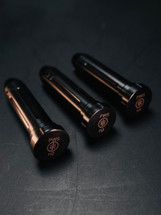Posted by WADE C. on Mar 28th 2025
BUFFA!!!
Dialing in Your Rifle: Why Buffer Weight Matters & Our Go-To Choice
If you’ve spent any time tuning rifles, you know that small adjustments can make a huge difference in how a rifle feels and functions. One of the simplest, yet most overlooked, tuning elements is buffer weight selection. Whether you’re running a 6.5 Grendel, 6 ARC, or .22 ARC, dialing in the right buffer can not only enhance your rifle’s recoil impulsebut also extend the life of critical components like your bolt.
We’ve long said that having a couple of different buffer weights on hand is a must for fine-tuning your rifle. That’s why we’re excited to stock Primary Weapons Systems (PWS) H2, H3, and H4 buffer weights—our top choice for balancing reliability, smooth cycling, and durability.
Why Buffer Selection Matters
The buffer weight you choose affects everything from recoil impulse to bolt carrier group (BCG) speed, and ultimately, the overall reliability of your rifle. Selecting the wrong buffer weight can lead to issues like:
-
Over-gassing & Bolt Stress – Too light of a buffer can cause excessive bolt velocity, leading to premature wear and shorter bolt life.
-
Under-functioning in Cold Temps – A setup that cycles perfectly in warm weather can struggle in extreme cold, especially with factory ammo.
-
Harsh or Unstable Recoil Impulse – Tuning for the softest shooting experience sounds great, but not at the expense of reliability across temperature swings and ammo variations.
Swapping buffer weights is quick, tool-free, and one of the fastest fixes for cycling issues in the field. Having the ability to adjust on the fly ensures that your rifle runs smoothly no matter the conditions.
Our Go-To Buffer Choices for ARC & Grendel Builds
When tuning a 6.5 Grendel, 6 ARC, or .22 ARC, we typically recommend:
✅ For non-suppressed or flow-through suppressors: Start with H2 or H3 ✅ For traditional baffled suppressors:H3 or H4 is usually the way to go
That said, tuning isn’t an exact science. There are many variables at play, from gas port size to ammo selection. That’s why we always carry a buffer weight that’s one step lighter than what we’re running. If we encounter any cycling issues, a quick swap eliminates a major variable instantly.
PWS Buffers: Built for Hard Use
One of the reasons we prefer PWS buffers over others is their machined cuts, which help shed dirt and debris. If you actually get out and run your rifle in the field, you know how important that is. The last thing you want is your buffer gumming up because of environmental junk.
Here’s the breakdown of the weights:
-
H2 – 4.4 oz
-
H3 – 5.1 oz
-
H4 – 6.8 oz
These buffers are built for hard use, and we’ve found them to be one of the best upgrades for fine-tuning a rifle’s recoil impulse and ensuring longevity of internal components.
Final Thoughts: A Simple Fix That Pays Off
If you’re looking to optimize your rifle’s performance, buffer weight selection is one of the easiest, fastest, and most effective adjustments you can make. Whether you're chasing the softest recoil impulse or simply trying to extend your bolt life, making sure you have the right buffer weight is key.
We have PWS H2, H3, and H4 buffers in stock now, so if you're building or tuning a rifle, grab a couple and dial in your setup the right way. A few extra ounces of weight can make all the difference in how your rifle runs.
Check them out and upgrade your rifle’s recoil impulse today.

